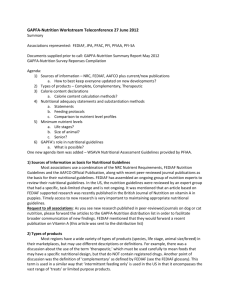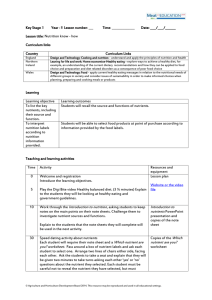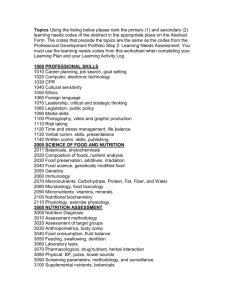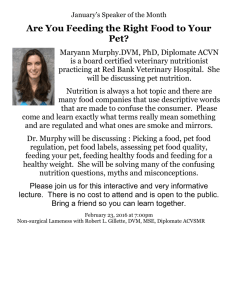- Pet Food Institute
advertisement
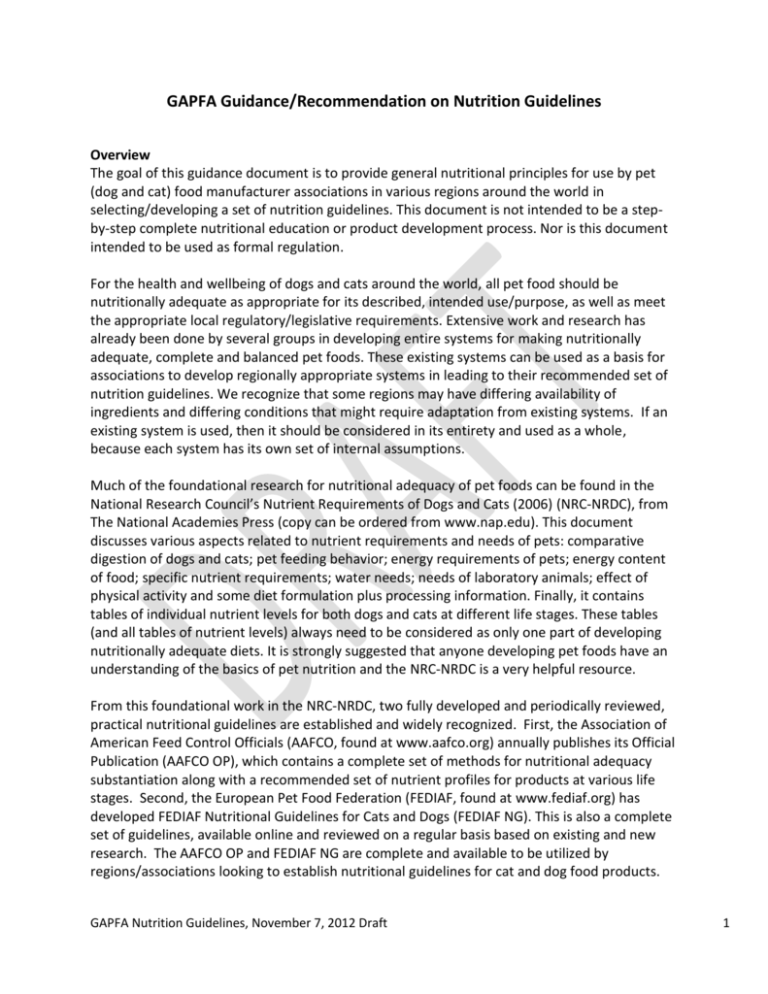
GAPFA Guidance/Recommendation on Nutrition Guidelines Overview The goal of this guidance document is to provide general nutritional principles for use by pet (dog and cat) food manufacturer associations in various regions around the world in selecting/developing a set of nutrition guidelines. This document is not intended to be a stepby-step complete nutritional education or product development process. Nor is this document intended to be used as formal regulation. For the health and wellbeing of dogs and cats around the world, all pet food should be nutritionally adequate as appropriate for its described, intended use/purpose, as well as meet the appropriate local regulatory/legislative requirements. Extensive work and research has already been done by several groups in developing entire systems for making nutritionally adequate, complete and balanced pet foods. These existing systems can be used as a basis for associations to develop regionally appropriate systems in leading to their recommended set of nutrition guidelines. We recognize that some regions may have differing availability of ingredients and differing conditions that might require adaptation from existing systems. If an existing system is used, then it should be considered in its entirety and used as a whole, because each system has its own set of internal assumptions. Much of the foundational research for nutritional adequacy of pet foods can be found in the National Research Council’s Nutrient Requirements of Dogs and Cats (2006) (NRC-NRDC), from The National Academies Press (copy can be ordered from www.nap.edu). This document discusses various aspects related to nutrient requirements and needs of pets: comparative digestion of dogs and cats; pet feeding behavior; energy requirements of pets; energy content of food; specific nutrient requirements; water needs; needs of laboratory animals; effect of physical activity and some diet formulation plus processing information. Finally, it contains tables of individual nutrient levels for both dogs and cats at different life stages. These tables (and all tables of nutrient levels) always need to be considered as only one part of developing nutritionally adequate diets. It is strongly suggested that anyone developing pet foods have an understanding of the basics of pet nutrition and the NRC-NRDC is a very helpful resource. From this foundational work in the NRC-NRDC, two fully developed and periodically reviewed, practical nutritional guidelines are established and widely recognized. First, the Association of American Feed Control Officials (AAFCO, found at www.aafco.org) annually publishes its Official Publication (AAFCO OP), which contains a complete set of methods for nutritional adequacy substantiation along with a recommended set of nutrient profiles for products at various life stages. Second, the European Pet Food Federation (FEDIAF, found at www.fediaf.org) has developed FEDIAF Nutritional Guidelines for Cats and Dogs (FEDIAF NG). This is also a complete set of guidelines, available online and reviewed on a regular basis based on existing and new research. The AAFCO OP and FEDIAF NG are complete and available to be utilized by regions/associations looking to establish nutritional guidelines for cat and dog food products. GAPFA Nutrition Guidelines, November 7, 2012 Draft 1 Again, when either the AAFCO OP or FEDIAF NG is used, then it should be considered in its entirety and used as a whole, because each system has its own set of internal assumptions. Within each of these two systems, there are common nutritional factors/principles considered in developing complete pet foods. These principles include: intended purpose; energy; nutrient content; digestibility; nutritional adequacy substantiation; and other considerations for targeted species (e.g., processing and ingredients). It may be that a company/region/association could want to develop a freestanding new set of nutritional guidelines. There may be regional circumstances that require such an approach. It would be hoped that newly developed guidelines are built from the foundational work already completed by the NRC-NRDC, FEDIAF and AAFCO and this document. The recommendation is that any newly developed guidelines encompass general nutritional principles and newer scientifically rigorous research findings where applicable. The existing references have, and continue to have, input from experts in cat and dog nutrition. Additionally, it is hoped that such newly developed guidelines would not become trade barriers. A possible Table of Contents for such guidelines documents could be: Overview Intended Purpose of Products Energy Requirements and Content Nutrient Content and Digestibility Nutritional Adequacy Substantiation and Verification Additional Nutritional Considerations References Intended Purpose Pet food must be nutritionally adequate for its intended use. The intended use/purpose of the pet food should be clearly stated on the package label. This document is intended to address products for healthy pets and does not include additional recommendations for other types of products such as lower or higher energy products. The following questions may be helpful in considering the intended use: What species is going to eat the product? Dog or cat? Is the product to be complete and balanced or complementary/incomplete? For what life stage of the animal is the product nutritionally adequate? All life stages or growth or adult maintenance? Is there some other purpose claimed on the product and if so what? Directions for use / feeding instructions The manufacturer should provide directions for the proper use of a pet food indicating the purpose for which it is intended. The feeding instructions should be clear and complete, and give an indication of GAPFA Nutrition Guidelines, November 7, 2012 Draft 2 the daily amounts to be fed. Feeding instructions could also provide information about the frequency of feeding, the need to have water available, and possible need to adapt the amount according to activity. Energy There are two considerations regarding energy: the energy need of the intended target animals and the energy content of the product itself. These two factors can be then used to develop feeding directions for complete products. Complete products should have feeding directions because they are intended as the sole source of nutrition for the target animal. The specifics on the labeling requirements are usually described in labeling guidelines/regulations. Determining the energy needs of the target animals (known as the metabolic energy requirement or MER) should be done using a scientifically valid method by the individual manufacturer based on the intended use of the product. The NRC-NRDC contains information pertinent to this determination. Methods of determining the energy of the product itself can be found in both the AAFCO OP and the FEDIAF NG, as well as in the NRC-NRDC. Two basic methods are used to determine the caloric content. First, and most commonly used, is the use of an equation (several options exist) to calculate the energy content from the nutrient composition of the product. This is often referred to as a ‘calculated’ method. The second methodological approach is actual feeding of the product (feeding trial or feeding protocol) and running analyses plus calculations. Nutrient Content Delivery of the proper amount and balance of nutrients to the target animal is the foundation of good nutrition. Once the intended purpose of the product and the energy are determined, the nutrient content can be developed. Both general nutrient category levels and specific nutrient levels can be considered. Some nutrients are considered to be required and essential, while others are not considered to be essential, but they may be considered as appropriate for the intended use of the food in the target animal. For the existing systems and for developing ones, working groups of nutrition experts review new research and consider the impact of nutrient balance and interactions when deciding upon/developing a set of nutrient recommendations. Nutrition experts can be from academe or industry, but all should have knowledge and experience with nutrition in the target animals and be able to critically review published research. Lists of recommended nutrient levels, sometimes called nutrient profiles, are available for dogs and cats in various life stages within each of these systems (AAFCO OP, FEDIAF NG, NRC-NRDC). Each set of nutrient levels have been developed based on a number of assumptions, nutrient balances, nutrient/product digestibility and interactions. It is critical to consider all the assumptions when using one of these lists and to use the appropriate list in its entirety because of the underlying assumptions for the respective system. While no minimum requirement is usually set for water, per se, it is an important nutrient. GAPFA Nutrition Guidelines, November 7, 2012 Draft 3 Water requirements are greatly affected by life stage, climate and exertion. Products may have an effect on water intake. Digestibility Not only must the animal eat the product (palatability), but the product must be sufficiently digestible so that the nutrients are available to the pet. Some ingredients may contain nutrients, but those nutrients may not be adequately available to the animal. One such example is iron oxide, which certainly contains iron, but not in a form that is available for absorption. Some nutrient classes, such as various fibers, are not necessarily absorbed, but are important to be considered in the overall nutritional delivery and functionality of the product. In general practice, digestibility of every nutrient is not determined. However, methods for determining dry matter and protein digestibility are provided in the AAFCO OP and FEDIAF NG (in the energy section). These determinations can result in valuable information on the function of a product. Nutritional Adequacy Substantiation The goal of pet food manufacturers is to make products that deliver on their claimed nutritional adequacy. How does a manufacturer, or for that matter a consumer, know that a product will deliver on its promise of complete nutrition? The answer is via nutritional adequacy substantiation. Methods of substantiating the nutritional adequacy are available in both the AAFCO OP and the FEDIAF NG. One method is via comparison of the established nutrient profiles as discussed in the Nutrient Content section above. For this method, the nutrient levels of the product are determined in one of two ways, either by calculations from the nutrient levels in the ingredients in the formula or via actual chemical analysis of all of the nutrients. The nutrient profile of the product is then compared to the established profile for the target animal in the life stage as consistent with the intended use of the product.. These comparisons may be made on a dry matter basis or on a per calorie basis. An additional method of substantiation is via actual feeding of the product. Several types of feeding trials are available: growth, reproduction, and adult maintenance with a combination of trials to support adequacy for all life stages. In these methods, various criteria are measured and evaluated to determine if the product can be considered nutritionally adequate. Product validation and verification Before a product is placed on the market, it should have undergone the necessary procedures to ensure its adequacy. The following nutrients should be taken into consideration for evaluation of nutritional adequacy (to be specified) Once a product has been passed and the formula remains essentially unchanged, it is recommended that regular assessments are conducted to make sure that the product still meets the appropriate nutritional standards and / or truly satisfies its claim of belonging to a family. The frequency of testing is the responsibility of the manufacturer. If the manufacturer makes a major change in the formulation or processing, complete re-analysis is recommended. GAPFA Nutrition Guidelines, November 7, 2012 Draft 4 Additionally, it is important that products continue to deliver adequate nutrition throughout the entire shelf life of a product. Possible environmental factors, nutrient interactions and product stability can impact nutritional delivery over time. Additional Considerations Many other considerations need to be taken into account when developing products that deliver the proper nutrition to pets. Some of these considerations are given in the NRC-NRDC, the AAFCO OP and the FEDIAF NG. They can appear in the text or as footnotes to the nutrient tables. Again, it is quite important to read the text and the footnotes of nutritional guidelines. Some additional considerations include: Palatable: the animal must eat the food in order to get the nutrients; Chemical form of the nutrient ingredient: this can influence availability, particularly for vitamins and minerals; Type of processing: some processes might reduce nutrient content or availability more than others; Stability of vitamins: stability should be maintained during storage as a premix, in the product after processing and during the entire shelf life of the product; Nutrient interactions: nutrients can interact and have a negative effect on nutrient levels; Oxidative stability of products: the reduction in oxidative protection of a product may reduce the nutritional delivery; Presence in the product of fish containing thiaminases: such ingredients can significantly reduce thiamin levels. Preservatives that might negatively impact thiamine levels, such as sulfur dioxide/sodium/potassium sulfites. Summary The goal of this guidance document is to provide general nutritional principles for use by pet (dog and cat) food manufacturer associations in selecting a set of recommended nutrition guidelines Two systems, AAFCO OP and FEDIAF NG, are fully developed, established, and functional in outlining practical nutritional guidelines for dogs and cats. When adopting one of these systems, a system should be adopted in its entirety given the specific assumptions within the respective system. Regardless of system, the common nutritional factors/principles in developing complete pet foods are: intended purpose; energy; nutrient content; digestibility; nutritional adequacy substantiation; and other considerations for targeted species (e.g., processing and ingredients). GAPFA Nutrition Guidelines, November 7, 2012 Draft 5
